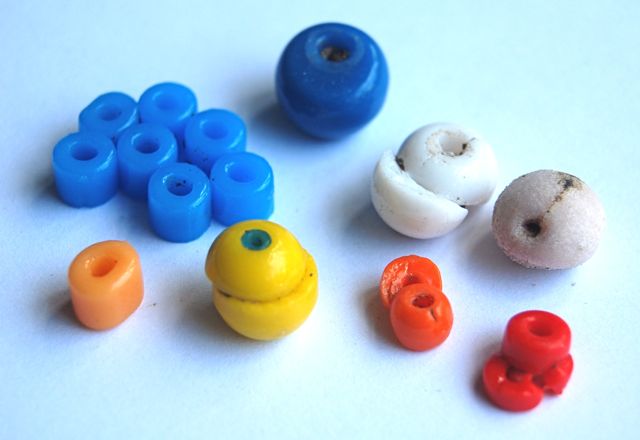| How prosser beads are made: for glass chemists out there... | |||||
| Post Reply | Edit | View All | Forum | ||
01/30/2011, 06:52:01
My best source so far has come from a German text found in Waltraud Neuwirth's Beads from Gablonz. It is a very specific book on beadmaking, and is written in both German and English. However, this text was only in German, so I translated it for my own purpose.
It comes from Otto W Parkert, and is written in 1925. It seems that he is a German chemist, who also lived in Jablonec. I am not sure of this, however. The beads are discussed as 'porcelain beads' which can be debated.
I thought maybe some of you, especially the glass chemists, might be interested in the translated text. I am not a chemist, not a native German or English speaker. It is probably riddled with mistakes. Please let me know.
Enjoy
I have also added a picture of the 'mass' of glass/porcelain and one of beads gone wrong at production from Briare.
-------
Otto W Parkert: The bead and its artificial production, 1925
The production of Porcelain beads
Very little is written in profesional literature on the actual production of Porcelain beads. This is probably due to the fact that only a few prevailing companies produce such beads. Still, we would like to go into this area of bead production, partly to clear up many of the widespread false views on Porcelain bead production.
It is impossible to determine when porcelain beads first entered the trade. The first attempts seem to date from the late 18th century, when biscuit porcelain was gaining interest from the public. It was also in this time that the porcelain button became more valued in fashion. The Wedgewood jewelry items that emerged from this gave rise to the start of the production of porcelain beads. It was Bapterosse in France who started this production with the ‘Bapterossemass’, named after him. Later it found its way to Germany and Austria.
One can actually say that the porcelain bead is an earthenware bead which comes quite close to older and long forgotten ways of fabricating earthenware beads, with it’s main difference being the transparancy of the beads. It comes down to the actual mix of the ingredients.
After the ingredients that are used, the different types of porcelain beads are called Agate or stonemass and streetmass beads. The first are generally made with a mix of muddy feldspar which is treated with an acid. Through this treatment the iron is removed and it is mixed with a small amount of phosphoric lime. The streetmass beads are made only with feldspar.
To crush the ingredients a large rotating drum sieve is used. It works in such a way that the feldspar goes through sieves that are smaller and smaller. The mass that is produced in this way is mixed with the appropriate binding agent. This can be milk, arabic gum, tragant gum, or a caseinglue mixture. It is stirred into a homogenous dough. Often, metal oxides or earthtones are added to colour the mixture evenly. The dough is rolled into plates of the needed thickness, The plates are placed in a pressing frame, of which the bottom part can be easily removed. The frame is placed underneath a specific pressing device. The holes in the beads are already made during this pressing. In the pressing device steel pins on a plug board are pushed through a punching die forming the holes. With this technique obviously different shapes of beads can be formed, but in the porcelain bead business round beads are the main product. Because of the simple pressing of beads, the work can be done very quickly. So fast that, depening on size and shape, 500 to 1000 and even more beads can be produced in one pressing. As stated before, the colouring of the mass is usually done during the mixing of the ingredients. Mostly used are metalcolours like cobalt, zink and chrome nickeloxide. We will show you here some recipes that are being used to give the reader a good idea of the quantities in the mixtures.
For brown, for every 100 T of basic mass, 20 T of calcinated. iron oxide is used and 15 T of zink oxide. For Green, 30 T of carbonate of zink, 7 T of titanium oxide an t T of zink oxide for every 100 T of basic mass. For black, 6 T of calcinated. cobalt oxide, 9 T of calcinated. iron oxide and 80 T of basic mass. For violet for 70 T of basic mass, 17 T of manganese oxide, 2 T of potassium nitrate and 12 T of bicarbonate of soda with the addition of 1 T of kobalt oxide.
With respect to the mixture of the basis mass, it is good to mention that one is aiming for a more glassy nature of the porcelain mixture. This is why there is a considerable number of recipes for making the mass which are mostly for the same intended use. Generally one can one can follow this one recipe, when you want to get satisfying results:
Swedish feldspar 95 T, Zettlitz Kaolin 18 T, potassium silicate 5 T, calcinated borax, 1 3/4 T.
Glazing is not needed with this material. As mentioned before, the mass can be coloured with specific metal salts or earth colours. To bind the mass, one of the mentioned binders are used to shape the mass into beads. After this, the beads are baked in a sleeve oven.
After Heinecke (German porcelain manufacturer from 1854-1932) sometimes the feldspar is replaced with a specific type of glass material to be used as flux.


|